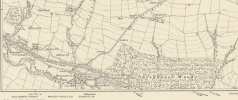High Dyke
Established Member
- Eastwell quarries 3'0"
- Waltham. 1000mm
- Thistleton. 3'6" overhead electric powered.
I've mentioned elsewhere on these forums that in the mid 1970s I worked on construction of a new dam for a water supply reservoir. The dam included a tunnel as part of the draw-off system, and the pipework and other equipment in the tunnel was moved into place using a narrow gauge railway operated with battery electric locos. The track was prefabricated panels known as Jubilee track, and I think was either 2' or 1' 11.5" gauge. The track panels were laid on timbers trimmed to the curvature of the tunnel invert (approximately!). The railway equipment belonged to the company and had been used on several previous dams, but that was the last time I knew of it being used.
Just had a quick look on Google Maps, yes they are.Another 3'6" gauge tramway was the Burton and Ashby Light Railway, unusual in being operated by a railway company (the Midland then the LMS) but also sharing street sections with the Burton tramway. There is (or at least I assume there still is) a short piece of track surviving in the forecourt of the closed Ashby station.
Also the Rye & Camber Tramway (1895 -- effectively, 1939): this -- steam, then internal-combustion -- in fact with the characteristics of a bona fide railway, rather than a steam tramway. The picture is got, that this poor little line is very often forgotten about in intended coverage of public narrow-gauge railways in Great Britain.The Southwold Railway in Suffolk was 3ft gauge, as was the Isle of Man railway.
Similar system in Horwich works.An internal system of 18inch gauge was in use at Crewe railway works - its success brought about a very large installation to the same gauge at Woolwich Arsenal for internal transport as well as an extensive network of standard gauge lines connected to the SE Railway's line at Plumstead.
IIRC the first line engineered by Col Stephens.Also the Rye & Camber Tramway (1895 -- effectively, 1939): this -- steam, then internal-combustion -- in fact with the characteristics of a bona fide railway, rather than a steam tramway. The picture is got, that this poor little line is very often forgotten about in intended coverage of public narrow-gauge railways in Great Britain.
Have you a reference to that railway, I've never heard of it before and a quick Google search doesn't throw anything up.The Sheffield corporation railway (1896-1912) had 3 rails so that stock of standard gauge and 3 foot gauge could run on the same track.
It ran from Stocksbridge to Langsett during the building of Underbank and Langsett reservoirs. It transported materials and labour to the sites.Have you a reference to that railway, I've never heard of it before and a quick Google search doesn't throw anything up.
Thanks, will look it upIt ran from Stocksbridge to Langsett during the building of Underbank and Langsett reservoirs. It transported materials and labour to the sites.
The Sheffield corporation railway (1896-1912) had 3 rails so that stock of standard gauge and 3 foot gauge could run on the same track.
Have you a reference to that railway, I've never heard of it before and a quick Google search doesn't throw anything up.
It ran from Stocksbridge to Langsett during the building of Underbank and Langsett reservoirs. It transported materials and labour to the sites.
Thanks, will look it up
I've heard it suggested that the Lynton & Barnstaple was based on the established Ffestiniog.
It's worth looking at the report on the accident between South Wingfield and Ambergate on 18th September 1840 which is available on the Railways Archive website. It was. a derailment, and one of the factors was that the North Midland Railway was built to a gauge of 4' 9": and some of the coaches were London & Birmingham ones, built to standard (4' 8-1/2") gauge.
So much for standard gauge! Interesting too that the L&B were running through coaches to Sheffield and presumably York so early in railway history - there was of course no 'East Coast' railway then..
I've finally got around to finding a map of it. This one from 1906 shows it best. It shows the section that ran past Midhopestones. I can't find one that shows the full alignment but the route is easy to see when walking in the area.Have you a reference to that railway, I've never heard of it before and a quick Google search doesn't throw anything up.


